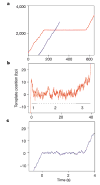Backtracking by single RNA polymerase molecules observed at near-base-pair resolution
- PMID: 14634670
- PMCID: PMC1483218
- DOI: 10.1038/nature02191
Backtracking by single RNA polymerase molecules observed at near-base-pair resolution
Abstract
Escherichia coli RNA polymerase (RNAP) synthesizes RNA with remarkable fidelity in vivo. Its low error rate may be achieved by means of a 'proofreading' mechanism comprised of two sequential events. The first event (backtracking) involves a transcriptionally upstream motion of RNAP through several base pairs, which carries the 3' end of the nascent RNA transcript away from the enzyme active site. The second event (endonucleolytic cleavage) occurs after a variable delay and results in the scission and release of the most recently incorporated ribonucleotides, freeing up the active site. Here, by combining ultrastable optical trapping apparatus with a novel two-bead assay to monitor transcriptional elongation with near-base-pair precision, we observed backtracking and recovery by single molecules of RNAP. Backtracking events ( approximately 5 bp) occurred infrequently at locations throughout the DNA template and were associated with pauses lasting 20 s to >30 min. Inosine triphosphate increased the frequency of backtracking pauses, whereas the accessory proteins GreA and GreB, which stimulate the cleavage of nascent RNA, decreased the duration of such pauses.
Figures



Similar articles
-
Real-Time Observation of Backtracking by Bacterial RNA Polymerase.Biochemistry. 2016 Feb 2;55(4):647-58. doi: 10.1021/acs.biochem.5b01184. Epub 2016 Jan 21. Biochemistry. 2016. PMID: 26745324 Free PMC article.
-
Dynamics of backtracking long pauses of RNA polymerase.Biochim Biophys Acta. 2009 Mar;1789(3):212-9. doi: 10.1016/j.bbagrm.2008.11.005. Epub 2008 Dec 6. Biochim Biophys Acta. 2009. PMID: 19101661
-
Dynamics of GreB-RNA polymerase interaction allow a proofreading accessory protein to patrol for transcription complexes needing rescue.Proc Natl Acad Sci U S A. 2017 Feb 14;114(7):E1081-E1090. doi: 10.1073/pnas.1616525114. Epub 2017 Jan 30. Proc Natl Acad Sci U S A. 2017. PMID: 28137878 Free PMC article.
-
RNA polymerase fidelity and transcriptional proofreading.Curr Opin Struct Biol. 2009 Dec;19(6):732-9. doi: 10.1016/j.sbi.2009.10.009. Epub 2009 Nov 13. Curr Opin Struct Biol. 2009. PMID: 19914059 Review.
-
[Mechanisms of action of RNA polymerase-binding transcription factors that do not bind to DNA].Biofizika. 2009 Sep-Oct;54(5):773-90. Biofizika. 2009. PMID: 19894614 Review. Russian.
Cited by
-
DNA Manipulation and Single-Molecule Imaging.Molecules. 2021 Feb 17;26(4):1050. doi: 10.3390/molecules26041050. Molecules. 2021. PMID: 33671359 Free PMC article. Review.
-
Characterization of a novel RNA polymerase II arrest site which lacks a weak 3' RNA-DNA hybrid.Nucleic Acids Res. 2004 Mar 26;32(6):1904-16. doi: 10.1093/nar/gkh505. Print 2004. Nucleic Acids Res. 2004. PMID: 15047857 Free PMC article.
-
Efficient modulation of subwavelength focusing via meta-aperture-based plasmonic lens for multifunction applications.Sci Rep. 2018 Sep 11;8(1):13648. doi: 10.1038/s41598-018-31860-1. Sci Rep. 2018. PMID: 30206269 Free PMC article.
-
Single-molecule tracking of mRNA exiting from RNA polymerase II.Proc Natl Acad Sci U S A. 2008 Jan 8;105(1):135-40. doi: 10.1073/pnas.0703815105. Epub 2007 Dec 27. Proc Natl Acad Sci U S A. 2008. PMID: 18162559 Free PMC article.
-
Stochastic sequence-level model of coupled transcription and translation in prokaryotes.BMC Bioinformatics. 2011 Apr 26;12:121. doi: 10.1186/1471-2105-12-121. BMC Bioinformatics. 2011. PMID: 21521517 Free PMC article.
References
-
- Erie DA, Yager TD, von Hippel PH. The single-nucleotide addition cycle in transcription: a biophysical and biochemical perspective. Annu Rev Biophys Biomol Struct. 1992;21:379–415. - PubMed
-
- Thomas MJ, Platas AA, Hawley DK. Transcriptional fidelity and proofreading by RNA polymerase II. Cell. 1998;93:627–637. - PubMed
-
- Erie DA, Hajiseyedjavadi O, Young MC, von Hippel PH. Multiple RNA polymerase conformations and GreA: control of the fidelity of transcription. Science. 1993;262:867–873. - PubMed
-
- Kunkel TA, Bebenek K. DNA replication fidelity. Annu Rev Biochem. 2000;69:497–529. - PubMed
Publication types
MeSH terms
Substances
Grants and funding
LinkOut - more resources
Full Text Sources
Other Literature Sources
Molecular Biology Databases

